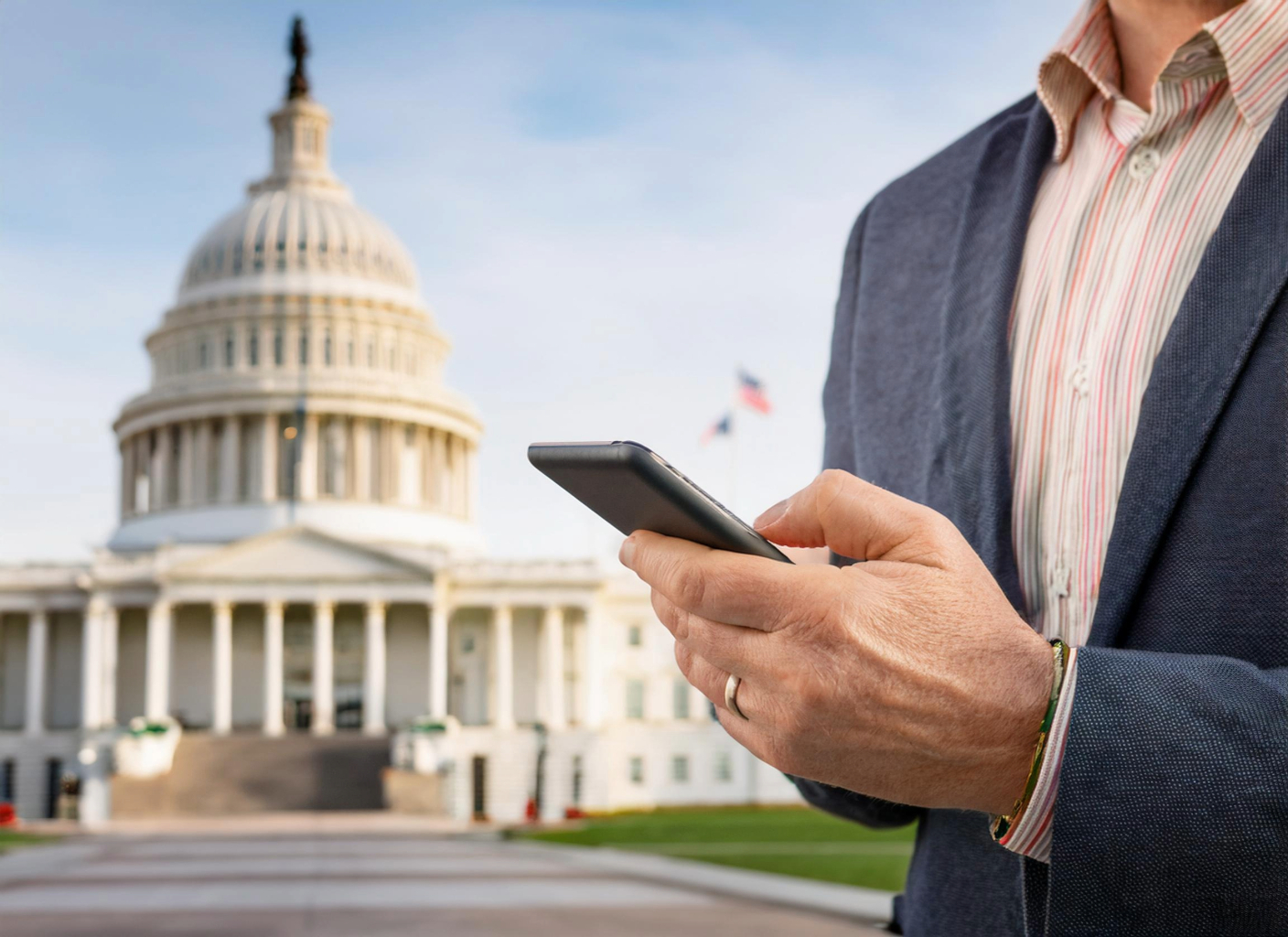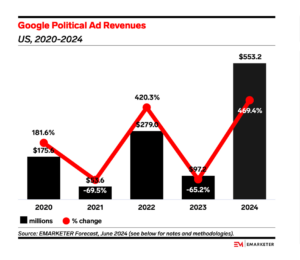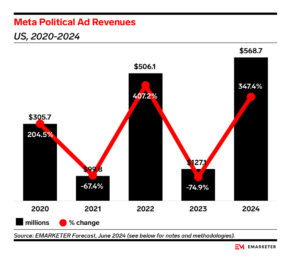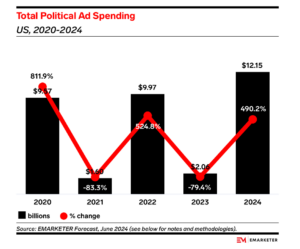
Outsmarting Election-Year Ad Frenzy
Maximize brand visibility in a politically charged market
The 2024 election cycle is another one for the history books, not just because of its political stakes but also because of the unprecedented projected surge in advertising spending. According to the latest figures from eMarketer, political advertisers are forecasted to pour over $12 billion across all channels—the largest ever seen in U.S. history.
Crafting a successful strategy during such a high-stakes period can feel like entering a competitive battleground. Political campaigns dominate airwaves, social media, and streaming services, driving up costs and making it harder for other advertisers to cut through the noise.
National advertising costs are expected to increase by at least 20%, with battleground states seeing at least double that increase.
Increased competition means increased costs. Most political spending is expected to funnel into linear TV advertising, a channel known for its broad reach and all-encompassing audience. Whether you typically invest in TV or not, this will inevitably drive up the demand—and the cost—for ad space across all channels.
With this enormous spending, marketers across industries may wonder:
- How can you stand out in a highly saturated media landscape?
- When and where can you most effectively reach your core audience?
- Should you even try to zig when they zag?
The good news is that your brand can and likely should continue to run campaigns during election years. Doing so, however, requires retooling your approach at a time when most other brands can’t or won’t even try. Here are key points to consider:
- Reassess Audience Demographics
Political campaigns target wide-ranging demographics, particularly in battleground states, where the highest political ad expenditures are expected. Therefore, it’s important to:
- Identify audience segments that political campaigns will likely attract
- Decide if you should compete directly or pivot to a different target
In battleground states, the competition for attention will be fierce. Questions to ask are whether you need to fight for these eyeballs. Based on that answer, also:
- Consider focusing on niche or overlooked audiences
- Regularly reassess audience strategy to avoid getting lost
- Strategically Select Target States
Not all states will be equally affected by political advertising. Battleground states will see the highest surge in competition, so it’s important to:
- Evaluate which states are worth investing in
- Allocate your budget strategically for efficiency and impact
If you choose to advertise in battleground states, make sure to:
- Plan ad spending with a competitive yet measured approach
- Avoid overspending where costs per impression are inflated due to political ads
- Plan Campagins To Avoid Election Dates
Election season brings peak moments of media attention—debates, primary elections, and election night. That means timing is everything. Avoid key election dates where political content dominates—and other campaigns can get overshadowed. Instead:
- Launch campaigns during quieter periods, offering presumably fatigued audiences a break from political ads
- Capitalize on post-election opportunities when the audience’s interest in non-political content spikes.
- Explore Alternative Advertising Channels
Traditional media, particularly TV, will be flooded with political ads, making it a more competitive and costly channel during election season. To avoid getting lost, consider:
- Shifting to digital platforms, social media, or streaming services for less politically saturated ad environments.
- Targeting younger, tech-savvy audiences as they are likelier to “cut the cord” from traditional TV.
- Leveraging precise targeting on digital platforms to reach the right audience at the right time.
- Accurately Track Campaign Performance
In a noisy advertising landscape, tracking your campaign’s success is crucial. Be sure to:
- Implement tracking systems to monitor engagement, impressions, and conversions.
- Make real-time adjustments to optimize campaigns based on performance data.
- Account for “election-year factors” that may distort traditional advertising benchmarks.
- Collaborate with Marketing Professionals for Effective Execution
Election-year advertising requires a well-coordinated, highly strategic approach. To ensure success, working with marketing professionals experienced in navigating political ad saturation can help. Together:
- Devise guidelines that will have your message break through even in the most competitive ad environments.
- Leverage their expertise to fine-tune targeting and optimize ad placements.
Outperform Without Overspending
In the unpredictable world of election-year advertising, leave October surprises to the news media and politicians. With the right planning and partnerships, you can stand out in a way that benefits your brand.
Success isn’t simply outspending the competition; it’s about having a precise, data-driven approach. By reassessing your audience, choosing your target states wisely, exploring channels beyond the obvious, and tracking your campaign performance in real-time, you can help your brand make an impact at a time when most other brands don’t. With a focus on precision rather than crossing your fingers and hoping you can break through, you’ll keep your message visible, impactful, and cost-effective in one of the most competitive advertising environments.

Google’s political ad spend is expected to increase in 2024, ballooning to a 469.4% increase, reflecting the dominance of digital platforms in election-year advertising.

Meta’s political ad revenues are forecasted to rebound in 2024, with a 347.4% increase from 2023, a significant increase after non-election-year declines.

Total political ad spending in the U.S. is projected to reach $12.15 billion in 2024, a 490.2% increase from 2023, marking a historic rise in election-year advertising.
Learn about LiveWorld digital and social media services and expertise.
###
Reach out the author, Tricia Kashima, Media Director, LiveWorld at tkashima@liveworld.com